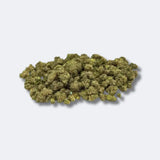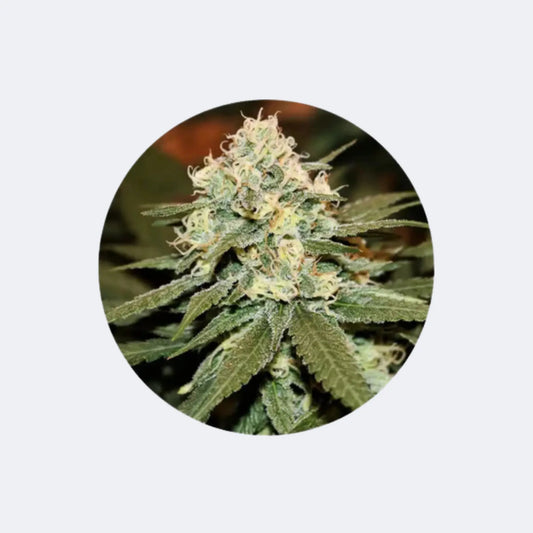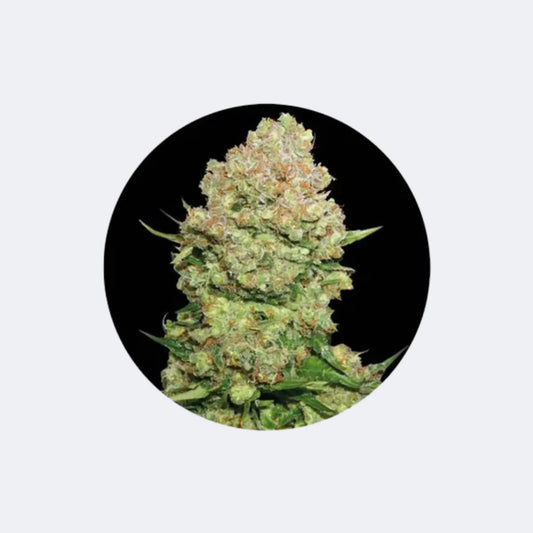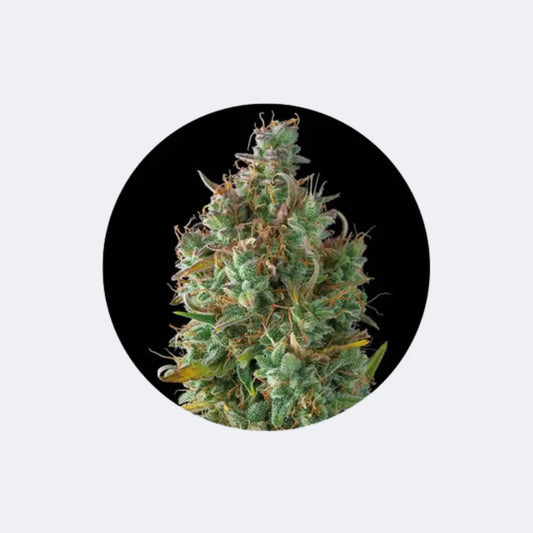
Detecting stress characteristics and diseases in cannabis plants
Andreas LeschkeShare blog post
How to tell when your beloved cannabis plant isn't doing well.
During the course of a cannabis cultivation, situations can always arise where our beloved medicinal and miracle plant signals to us that it's not feeling well. While weed can't talk, it does let us know visually by sending out optical signals when it needs our help.

I'd like to emphasize right from the start that this can happen not only to inexperienced growers, but even to the most experienced professionals. While there are so-called "general formulas" for the basic needs of cannabis, these can vary greatly from genetic to genetic. For example, one genetic in the inner tent might be satisfied with about 200 ml of water, while another genetic of roughly the same size might need twice as much. The same can affect the need for CAL/MAG (calcium, magnesium) as well as plant fertilizer.
For this reason, it's important to read the cannabis plant through regular checks (once a day) and understand what it's trying to tell us when it's stressed and suffering. Only then can we provide quick and targeted help by understanding the underlying stress symptoms and taking the appropriate measures.
Similar to the blog post about pest control, there are countless "diseases," so in this post I will again focus on the most common stress symptoms of weed ladies.
Limply hanging palm leaves, as well as yellow leaves
There are two possible causes for this symptom: either an oversupply of irrigation water or an undersupply.
Therefore, further features should be considered:
If the leaves don't curl and don't show any dry spots, such as dry, crispy leaves, the cause is likely an overwatering of the potting soil. However, this could also be due to an underwatering if the plant hasn't been watered for a while.
Another sign of overwatering is yellow, very light green leaves that are not dry, but rather weak, soft, and droopy. Overwatering leads to stunted growth of the plant, as the excessive amount of water prevents it from extracting sufficient nutrients from the soil.
Therefore, the substrate should always be kept moist, but not wet, if possible!
For these reasons, it is important to check the soil and feel whether it is too wet or too dry, as one of the two is likely to be the cause.
If the soil is dry, you can quickly remedy the problem by adding enough water to the soil until it is moist again.
However, if there's too much water in the soil, you should first check the saucer and, if there's any water in the saucer, pour it out. Then, of course, you should refrain from watering until the plant has recovered and the soil is only moist.
Another measure to consider is examining the plant's soil. Waterlogging in the soil can not only cause the roots to rot, but can also lead to the formation of toxic mold, which can later be transferred to the plant.
This mold can be easily identified on the ground when a furry white, green or gray layer has formed.
If this is the case and the mold infestation is still in its early stages, with patches measuring no more than 1 cm x 1 cm, it's still sufficient to remove and dispose of the top 2 to 3 cm of soil. Then simply refill with new soil.
However, if the soil is already heavily infested with mold, I would strongly recommend removing the plant from this soil, washing the roots, and then repotting it in new soil.

2. Yellow, pale leaves on the cannabis plant
As already described, yellow leaves are a result of overwatering the growing medium. Due to the excessive water content in the plant's growing medium, the plant cannot absorb sufficient nutrients to develop and grow. It is therefore logical that yellow or pale leaves are a sign of underfertilization, because the soil has lost too many nutrients due to excessive watering.
For this reason, in addition to the measures already described that should be taken in case of overwatering, it is advisable to add tomato fertilizer to the growing medium so that the plant can quickly absorb the necessary nutrients to recover.

3. Mold on the Cheshire Grass Lady
Mold infestation in cannabis is usually caused by overwatering, excessive humidity, and insufficient air circulation. Therefore, preventative measures can be taken by ensuring that humidity in the grow tent doesn't exceed 64% and that there is sufficient ventilation and air circulation!
Mold on our beloved medicinal plants can be identified by abnormal discoloration on the plant. If dark green or gray-white spots have formed with a fuzzy, powdery substance on the surface, the plant is infected with mold. In addition, you may notice a rotten, musty odor from the cannabis plant.
Action should be taken IMMEDIATELY to avoid getting a toxic product at the end of the flowering phase, which can harm the human organism.
First, ideal climatic conditions should be created, as described at the beginning. If humidity is too high, dehumidifiers should be used until the values fall below 64%.
The good news is that mold infestation on the plant can be combated and eliminated quickly and effectively.
To do this, mix 16 grams of baking soda with one liter of water and spray the entire plant with about half of the solution. Pour the remaining 500 ml of the mixture into the soil so that the baking soda can also be absorbed through the roots. This not only combats mold in the soil and on the roots, but also gives the plant a little boost to help it recover faster.
Baking soda, also known as baking powder, acts as a fungicide. It kills mold by disrupting the balance of ions in the mold cells.
Afterwards, the plant should be checked 3-4 times a day to monitor the progress of the control. Depending on the severity of the mold infestation, one application may not be sufficient, so the process should be repeated 2-3 days later.

4. Burnt leaves on your favorite plant
If the leaves appear burnt at the edges, causing them to curl, become crispy, and take on a dark color, this is due to excessive fertilizer application.
Please keep in mind that over-fertilization can lead to nutrient blockages, thus impairing plant growth. It's much easier to cure an under-fertilized plant than an over-fertilized one.
If over-fertilization occurs, action should be taken immediately.
You can either repot the plant in new soil and only water it daily until the plant recovers, or you can rinse the plant's nutrient medium until only water with a little soil comes out of the bottom holes of the pot. Initially, a brown liquid will run out, so you should be able to see it quite clearly once the fertilizer has been rinsed out.
Personally, however, I would recommend rinsing the soil rather than repotting the Cannabis Lady, as repotting causes further stress for the plant, which will then result in it taking longer to recover.

5. Red, purple discoloration of leaves and stems, brown wilting healthy leaves, burnt leaf tips, yellowish leaves with green veins and stunted growth
All of these symptoms indicate a pH level that's too low. This can be quickly remedied by applying some lime to the soil and then watering it so the lime can seep into the soil. Monitor the pH level with a pH meter until it returns to the normal range of 5.5 to 7! If one application isn't sufficient, simply repeat the process a day later.
6. Brown spots on the leaves of your cannabis plant, stunted wilted leaves, dying tips of new leaves, dark green leaves with a reddish, purple tint
These symptoms indicate a pH level that's too high. This can be remedied by mixing a little citric acid into the watering can and then watering the soil. One teaspoon of citric acid mixed with one liter of water can lower the pH by more than 0.2. Therefore, please be very careful with the dosage and then monitor the pH level until it returns to normal.
An incorrect pH level, whether too high or too low, results in certain nutrients being blocked in the soil. This leads to deficiencies in plants that impair growth and health, which can result in yield losses or, in the worst case, the loss of the entire plant.

7. Bent young leaves, brown and yellow spots on the tips and on the surface of the older leaves, which slowly die
If these symptoms occur, a Cal/Mag deficiency is present. The consequences can be devastating. If too many leaves die, the plant can no longer produce the necessary nutrients in the leaves to supply the plant with them. This ultimately leads to the plant literally starving.
A CALMAG fertilizer can help here, which you can order online for as little as €5, or you can mix your own fertilizer. I'll explain how to make your own CALMAG fertilizer in another blog post at a later date.
The CALMAG fertilizer can and should be mixed into the irrigation water, but can also be used as a spray solution to spray the leaves for quick relief.
8. White tips on the leaves or buds
The stress symptom of a cannabis plant exhibiting white tips on its leaves can occur even at a very early seedling stage. However, it can also occur during flowering, when buds and leaves begin to develop white tips. This is a stress symptom that only occurs in indoor grows when LEDs are used for lighting.
Simply explained, it means that the plant has "LED STRESS" or "LIGHT STRESS" because, according to its genetics, it receives too intense light.
The differences in genetics can be so significant that if you plant three different genetics, only one of them will be affected, while the other two fun plants will be visibly fine.
The solution is quite simple: dim the LEDs a bit. If you don't have a dimmer switch, you can and should hang the LED lamp higher, creating a greater distance between the light source and the plant.
It's important to note that the white spots that have already appeared will remain. However, you can tell whether the stress from overexposure has subsided by looking at the newly growing leaves and buds, as they begin to return to their normal appearance. Otherwise, the light should be dimmed even further or the lamp should be moved further away from the Cannabis Lady.
In conclusion:
Please note that if your cannabis plant exhibits symptoms that I haven't mentioned in this blog post, it's most likely related to a pest infestation. Please check out our blog post on biological pest control in cannabis cultivation , as I've already listed these symptoms there.
We thank the author Jorge Rieger for this blog post on the topic of recognizing stress traits and diseases in cannabis plants. Feel free to follow him on his Facebook account. --> Click here







2 comments
Danke der Blog ist sehr informativ und ich werde ein bisschen Geld sparen und ein Vape und ein paar Blüten bestellen!.Danke für die gute Aufklärung bei den Krankheiten unserer Heilpflanze!💚💚💚🫶🏻💪🏻👍🏻
Danke der Blog ist sehr informativ und ich werde ein bisschen Geld sparen und ein Vape und ein paar Blüten bestellen!.Danke für die gute Aufklärung bei den Krankheiten unserer Heilpflanze!💚💚💚🫶🏻💪🏻👍🏻